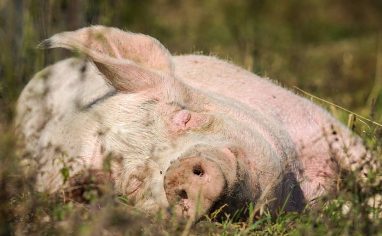If you are caring for animal residents, especially those who are new to the sanctuary, unaccustomed to humans, have previously had negative experiences with humans, or have personalities that desire their own space, understanding what the flight zone is and how to appropriately navigate it can help you build a good relationship with residents and help ensure they feel comfortable and safe. Each interaction you have with a resident is an opportunity to build trust and a sense of safety. Negative experiences, even unintentional, are remembered and can affect how the resident perceives a particular caregiverSomeone who provides daily care, specifically for animal residents at an animal sanctuary, shelter, or rescue., volunteer, or even humans in general. Things like medical care, transportation, and moving into a new space are often stressful for animals, so developing a good relationship with residents is important to ensure that their overall feelings are ones of safety and comfort. While positive reinforcement learning, gradual introduction to new things, and taking things slow are all helpful when it comes to making residents feel safe, learning about flight zones and how to best approach residents can go a long way in promoting positive experiences for residents in all interactions.
What Is A Flight Zone?
In the simplest terms, a flight zone, also called a flight distance, is a nonhuman animal’s personal space. How close can someone get to you before you take a step back? This likely varies depending on the relationship you have with that person (close friend, coworker, stranger, grandparent, and so forth), your personal experiences and preferences, your personality, and even your cultural experiences. Nonhuman animals also have levels of comfort surrounding space with humans! The flight zone is the space around an animal where they become uncomfortable and will move away when that boundary is crossed.
Different species may have different general flight zones. This might be most clearly demonstrated in examples between wildlife and domesticatedAdapted over time (as by selective breeding) from a wild or natural state to life in close association with and to the benefit of humans species, where wildlife tends to have a much larger flight zone. Consider wild rabbitsUnless explicitly mentioned, we are referring to domesticated rabbit breeds, not wild rabbits, who may have unique needs not covered by this resource. versus domesticated rabbits in this instance. However, domesticated animals also have a flight zone, even if smaller. Their history with humans can also play a large part in their comfort levels around humans, affecting their flight zone. And, since everyone is an individual, some residents may just have personalities or temperaments that tend to prefer more distance between them and humans. Let’s take a closer look at factors that may affect the size of someone’s flight zone:
Factors That May Affect Flight Zones
Approach
It is important to have a thorough understanding of the species you are working with and, when possible, information on their past experiences, behaviors, and personalities. A resident’s flight zone may increase or decrease based on how a caregiver approaches them. It is important to learn about the vision of the species you are caring for in order not to approach their blind spots. Approaching in someone’s blind spot may surprise them when they notice you, causing them to move away quickly. Overly direct approaches can also make some feel uncomfortable. It’s important to approach a resident where they can see you and attempt to make your way closer in a calm manner. Avoid sudden movements and speak quietly. The swiftness of the approach can also affect someone’s flight distance. Rushing can make someone feel threatened.
Range Of Vision
Different animals have different ranges of vision, blind spots, and depth perception. This can all play a part in the size of their flight zone. Animals who graze generally have a wide range of vision, which allows them to see potential threats. For example, horses (and a number of other species) have binocular vision in front of them and peripheral monocular vision, creating a wide range of peripheral vision but lacking depth perception. This means they can easily detect movement but can’t always readily tell quite how far away the movement is. Horses also have a blind spot directly behind them and directly in front of their nose. This is important to know in order to avoid approaching them in their blind spots which are likely to startle them. Additionally, when it comes to fight or flight, horses generally choose flight. If cornered, a horse may panic and run right over the top of the human in their path. Be sure to understand the range of vision and normal behaviors of each species you care for so you can better understand their flight zones and act appropriately. If a resident has loss of vision, they may feel vulnerable and nervous and their flight zone might be more affected by sounds.
Hearing
Residents who are deaf or hard of hearing may be more easily startled. Their flight zone may seem smaller if they can’t hear you approach and you are out of sight, but you may frighten them more easily and must take this into consideration. You don’t want to startle them and cause them to feel nervous.
Time Of Day
If you have a daily afternoon routine with Timothy the goat, who has required daily care of an abscessed hoof, you may find that Timothy’s flight zone increases in the afternoon. There are many other instances where expected routines and schedules can influence a resident’s flight zone.
Known Negative Objects
Building on the example above, you may also find that Timothy’s flight zone increases if he sees a caregiver with a medical kit and decreases if they have nothing in their hand. Residents can often be keenly aware of what’s coming and will likely modify their behavior to avoid situations they perceive as negative.
Unknown Objects
Someone’s flight distance may also increase if they see something new that they are unsure of. A caregiver wearing a new hat or a ball intended for enrichment can both provoke a flight response depending on the individual. This is why enrichment should be done with care and close observation. Remember, it is only enriching if the resident finds it to be!
Social Relationships
A resident’s social relationships with others in their group can also affect flight response. Some individuals may be more comfortable around humans when their social group is also present. Conversely, emotional contagion can cause one resident to move away because their buddy moves away when a human approaches. A herd animal may also have a larger flight zone when isolated, depending on other factors.
Personality/Temperament
Personality comes into play here as well. Some individuals are naturally bolder than others, making them generally less fearful of new objects or situations. Their flight zone may be smaller than a flockmate’s, who is generally shyer.
Relationship
Of course, an individual’s flight distance may also be affected by whether they know the person approaching or not. They may move away from new caregivers or volunteers sooner than if someone they knew approached them.
History
Sadly, some residents may have experienced abuse before arriving at the sanctuary. This might leave deep mental scars that may never be fully healed, though it is so wonderful when they are! Other residents may have been well cared for and enjoyed a comfortable relationship with a human previously. Their past experiences can greatly affect their flight zone.

Are You Sure They’re Comfortable?
It is important to remember that some individuals may have been treated so badly that they acquired a sort of learned helplessness and don’t move away even if they are uncomfortable. If at all possible, be careful to ensure residents are giving positive cues that they are content, comfortable, or feel safe when working with them.
Species
As mentioned above, species differences generally affect their flight zones, which often is influenced by how each species evolved, their native habitats, and their typical environmental risks. It’s important to learn about each species you care for so you can have a good understanding of how they see the world (literally) and normal behavioral patterns for each species, as these can affect how you should approach them.
Shrinking The Flight Zone
Measuring flight zone can be a good indicator of comfort as new residents slowly allow caregivers to move closer. In order to “shrink” the flight zone, residents need to feel secure. Positive and neutral experiences with humans will help. A negative experience will reinforce a flight zone and may even cause it to increase. Unfortunately, as caregivers, we have to provide care that can be less than pleasant, such as dressing a wound or moving a resident to a new living spaceThe indoor or outdoor area where an animal resident lives, eats, and rests.. It’s important to ensure these experiences are as unstressful as possible. Careful observation of body language can help caregivers know how and when to approach. Positive reinforcement learning can also help residents associate positive experiences with otherwise uncomfortable situations. It is important to start this work well ahead of time, as rushing it will not bring about the desired result. Work on things like walking, loading into a trailer, touching feet, and so on before there is an emergency. This will help build a strong relationship with the resident, as well as foster comfort in these situations.
Safety First!
Certain resident species, particularly larger residents, may panic and run right at caregivers, potentially knocking them to the ground and stepping on them. It is important for staff to be aware of their surroundings and understand how the species and individuals may react to their approach. Don’t corner them, if possible, and have an exit strategy in mind when approaching them. Additionally, panicked residents may injure themselves or other residents trying to escape. Care must be taken to ensure residents feel comfortable when you approach.
We hope this introduction to flight zones will help you develop positive relationships with residents by gaining a better understanding of their boundaries. Knowing these will allow staff and volunteers to respect the personal space of individuals and learn how to tailor their approach for successful interactions with residents.
SOURCES:
Animal Behavior And Restraint: Swine | The Center For Food Security And Public Health (Non-Compassionate Source)
Animal Behavior And Restraint: Equine | The Center For Food Security And Public Health (Non-Compassionate Source)
Horses’ Responses To Variation In Human Approach | Applied Animal Behaviour Science (Non-Compassionate Source)
Alpacas And Llamas (And Other Camelids) Standard Operating Procedures | Queensland Schools Animal Ethics Committee (Non-Compassionate Source)
Chapter 1 – Handling And Examining Sheep And Goats | Sheep And Goat Medicine (Non-Compassionate Source) (Non-Compassionate Source)
If a source includes the (Non-Compassionate Source) tag, it means that we do not endorse that particular source’s views about animals, even if some of their insights are valuable from a care perspective. See a more detailed explanation here.








